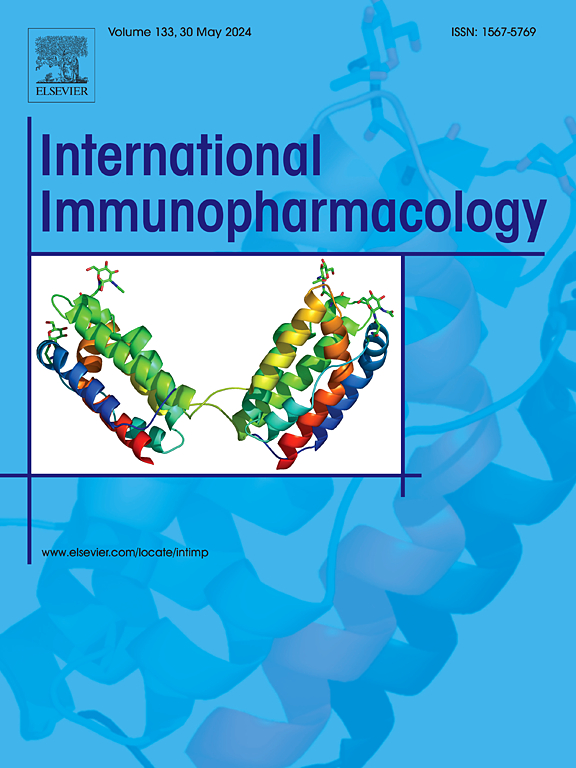Novel therapeutic approach in periodontitis: Sulforaphane attenuates disease progression via Nrf2-mediated antioxidant defense
IF 4.7
2区 医学
Q2 IMMUNOLOGY
引用次数: 0
Abstract
Periodontitis, one of the most prevalent global disorders, is characterized by oxidative stress-mediated pathogenesis that leads to progressive tissue destruction and bone loss. Given that nuclear factor erythroid 2-related factor 2 (Nrf2) is essential for cellular antioxidant defense, targeting this pathway may represent a promising therapeutic strategy. Sulforaphane (SFN), a natural isothiocyanate with potent antioxidant properties, has been confirmed to be effective against various oxidative stress-related disorders. This study aimed to investigate whether and how SFN attenuates periodontitis progression through Nrf2-mediated antioxidant defense activation. Our study demonstrated that SFN effectively suppressed inflammatory responses induced by Porphyromonas gingivalis Lipopolysaccharides (P. gingivalis LPS) in human gingival fibroblasts (HGFs) in vitro and attenuated periodontitis progression in an experimental rat model. In HGFs, SFN significantly reduced inflammatory mediator production, decreased intracellular and mitochondrial reactive oxygen species (ROS) accumulation, and restored mitochondrial function. Mechanistically, the anti-inflammatory and antioxidant effects of SFN were Nrf2-dependent, as demonstrated by their abolishment in Nrf2-silenced HGFs and enhancement in Nrf2-overexpressing cells. Additionally, SFN alleviated periodontal tissue damage and reduced inflammation in a periodontitis rat model, accompanied by enhanced antioxidant capacity. These results demonstrate that SFN ameliorates periodontitis by activating Nrf2-dependent antioxidant defense, suggesting its therapeutic potential for periodontal treatment.

牙周炎的新治疗方法:萝卜硫素通过nrf2介导的抗氧化防御减缓疾病进展
牙周炎是全球最普遍的疾病之一,其特点是氧化应激介导的发病机制导致进行性组织破坏和骨质流失。考虑到核因子红细胞2相关因子2 (Nrf2)对细胞抗氧化防御至关重要,靶向这一途径可能是一种很有前景的治疗策略。萝卜硫素(SFN)是一种天然异硫氰酸酯,具有强大的抗氧化特性,已被证实对各种氧化应激相关疾病有效。本研究旨在探讨SFN是否以及如何通过nrf2介导的抗氧化防御激活来减缓牙周炎的进展。我们的研究表明,SFN在体外有效地抑制牙龈卟啉单胞菌脂多糖(P. gingivalis LPS)诱导的人牙龈成纤维细胞(HGFs)的炎症反应,并在实验大鼠模型中减缓牙周炎的进展。在hgf中,SFN显著减少炎症介质的产生,减少细胞内和线粒体活性氧(ROS)的积累,恢复线粒体功能。从机制上讲,SFN的抗炎和抗氧化作用依赖于nrf2,其在nrf2沉默的HGFs中被消除,在nrf2过表达的细胞中被增强。此外,在牙周炎大鼠模型中,SFN减轻了牙周组织损伤,减少了炎症,同时增强了抗氧化能力。这些结果表明,SFN通过激活nrf2依赖的抗氧化防御来改善牙周炎,提示其在牙周治疗中的治疗潜力。
本文章由计算机程序翻译,如有差异,请以英文原文为准。
求助全文
约1分钟内获得全文
求助全文
来源期刊
CiteScore
8.40
自引率
3.60%
发文量
935
审稿时长
53 days
期刊介绍:
International Immunopharmacology is the primary vehicle for the publication of original research papers pertinent to the overlapping areas of immunology, pharmacology, cytokine biology, immunotherapy, immunopathology and immunotoxicology. Review articles that encompass these subjects are also welcome.
The subject material appropriate for submission includes:
• Clinical studies employing immunotherapy of any type including the use of: bacterial and chemical agents; thymic hormones, interferon, lymphokines, etc., in transplantation and diseases such as cancer, immunodeficiency, chronic infection and allergic, inflammatory or autoimmune disorders.
• Studies on the mechanisms of action of these agents for specific parameters of immune competence as well as the overall clinical state.
• Pre-clinical animal studies and in vitro studies on mechanisms of action with immunopotentiators, immunomodulators, immunoadjuvants and other pharmacological agents active on cells participating in immune or allergic responses.
• Pharmacological compounds, microbial products and toxicological agents that affect the lymphoid system, and their mechanisms of action.
• Agents that activate genes or modify transcription and translation within the immune response.
• Substances activated, generated, or released through immunologic or related pathways that are pharmacologically active.
• Production, function and regulation of cytokines and their receptors.
• Classical pharmacological studies on the effects of chemokines and bioactive factors released during immunological reactions.

 求助内容:
求助内容: 应助结果提醒方式:
应助结果提醒方式:


